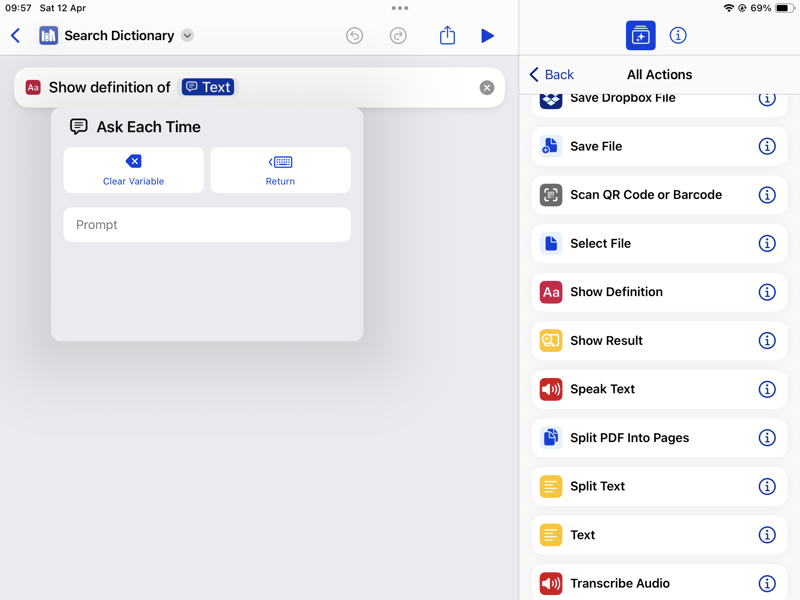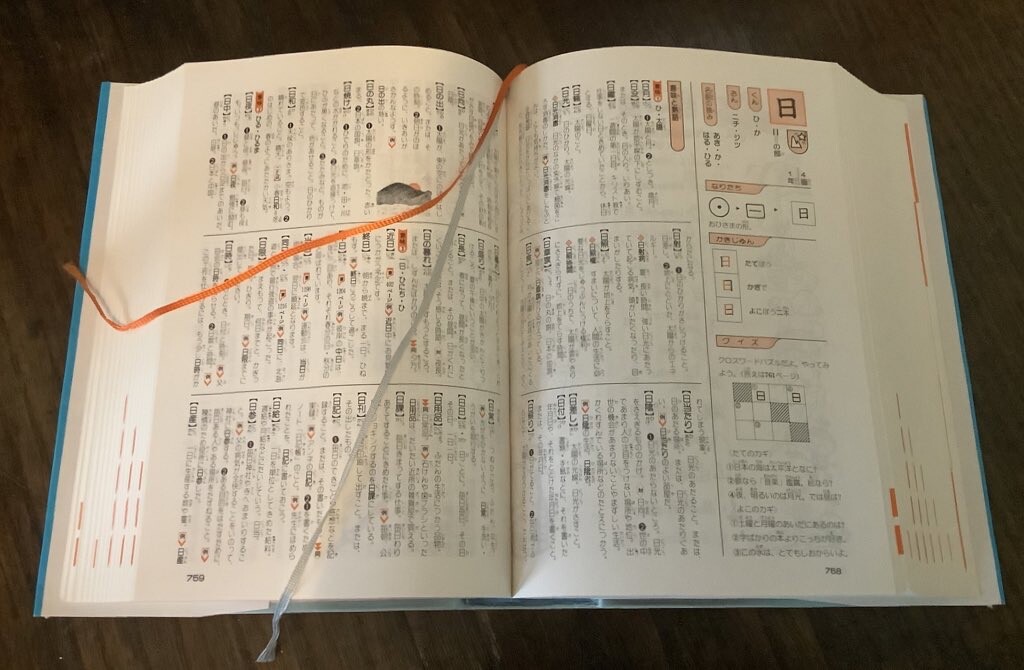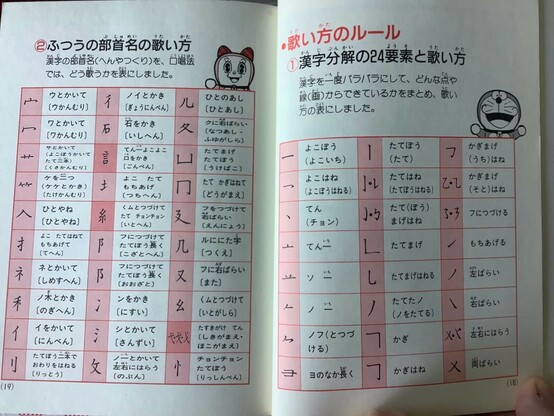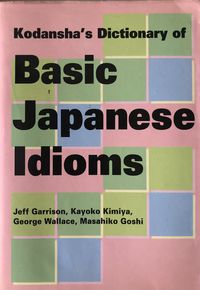Table of Contents
Japanese Dictionaries

iOS and iPadOS
Japanese (Dictionary App)

★★★★☆
Free - No Ads - No subscription
last update December 2019
https://apps.apple.com/gb/app/japanese/id290664053
Of the available edict based dictionaries I like this one the best. I've never felt the need to change it to another offering. Its search is fast. Input can be romaji, kana, kanji, or english. For kanji input it has multi radical input or a reasonable handwriting recognition.
It uses JMdict as its source data. The Tanaka Corpus is used for examples, which at times aren't the best or carefully curated. (at least it's not Tatoeba dot org)
It has extended features like flashcards, lists and multi lookup of a pasted text.
I have only ever used the custom lists. The lists can be exported as text files and cleaned up as needed with grep.
Kodansha Kanji Learners Dictionary

★★★☆☆
Paid (£20, $30, ¥3,000) - No Ads - No subscription - iPad only
last update May 2024
https://apps.apple.com/gb/app/kanji-learners-dictionary/id716481897
I seem to have bought this 3 or 4 times. Once as a paper copy 1st edition. Then as an app. It was a good price but withdrawn due to some rights issue. (The dictionary's compiler actually commented on my website about it.) The official app which was near identical. and an upgrade to the 2nd edition.
So I guess you can say I like this.
A bundle exists with the 2 ancillary apps for Synonyms and Usage saving around £12
I think SKIP is past its best-by date. Multi-radical is better suited to computers, alternatively direct drawn input on iOS or ocr using the camera. It does have a classic radical index, which is ok if you can identify the radical and count the strokes. By and large I'm using copy and paste to do searches.
It’s a good kanji dictionary and despite its relatively expensive price for an iOS app it’s a bargain compared to a print edition. I trust its english headwords more than KANJIDIC. I recommend it.
例解学習国語辞典

★★★★☆
Paid (£15, $15, ¥2,000) - No Ads - optional extra paid feature available - iPad only
last update January 2017
https://apps.apple.com/gb/app/id615900736
This is an app aimed at Japanese primary school children from 物書堂 Monokakido.
A nice app. It has clearer layout and fonts than an adult dictionary. Its simpler Japanese more limited word set makes it easier to work in as a learner. All the words have furigana. The interface can be adjusted according to grade level.
Search is aided by handwriting recognition, character by character. Otherwise you can copy and paste or directly type searches in Japanese.
A nice feature is pitch accent entries. The only time I've seen these before was in the expensive NHK pronunciation dictionary.
There are also kanken practice tests. A free one for each level but others can be bought for £2 per level for 10 tests or more.
You can add your own photographs to entries, which has possibilities. A feature I made for myself in my Kanji Notebook.
Dictionaries (from Monokakido)

★★★★☆
Free - No Ads - No subscription
last update September 2024
https://apps.apple.com/gb/app/dictionaries/id1380563956
By itself it doesn't have any content, it is a front end for Monokakido's paid dictionaries. So “free” is somewhat relative.
The benefit is lookup across several dictionaries at once and a common interface. Purchases on iOS will also run on the desktop version. The desktop version requires OSX 11.3 or higher.
I think the desktop version can access the system dictionaries. Unfortunately Apple has the system dictionaries locked down on iOS and they can only be accessed them via the contextual menu (mostly), hampering usefulness.
There is comprehensive cross indexing and everything can be hightlighted and copied or searched.
I use the following dictionaries with it:
Ace Crown E -> J Dictionary 3rd edition

https://www.dictionarystore.com/en/dictionaries/ace3/
Another children’s dictionary. This time an English dictionary for middle school and high school. The benefit is the phrasing between English and Japanese has been curated and your are more likely to get a good equivalent using this rather than edict for E to J.
ReikaI Gakusyu Kokugo Jiten

https://www.dictionarystore.com/en/dictionaries/rgko11
An elementary school (grades 1 to 6) Japanese dictionary. It is very similar to 例解学習国語辞典
ReikaI Gakusyu Kanji Jiten

https://www.dictionarystore.com/en/dictionaries/rgka9
An elementary school Kanji dictionary. It is reasonably comprehensive for any learner, covering 3000 characters. Each entry has stroke order, sometimes writing tips, an etymology なりたち, meanings and examples covering each on and kun readings.
Its radical index is interesting in that it takes you to an entry explaining the radical which then lists the entries for that radical. Useful if you can correctly identify the radical.
Nihongo Bunkei Ziten: English

https://www.dictionarystore.com/en/dictionaries/jgp
A dictionary of grammar in English. Not as detailed as The Japan Time's dictionaries but much cheaper. Each entry has a brief description of usage and several examples.
iOS built-in dictionaries
★★★★☆
Free (as long as you own an Apple device!)
iOS has high quality built-in language dictionaries. You need to install them via Settings → General → Dictionary. Japanese has the スーパー大辞林 and the ウィズダム英和辞典/ ウィズダム和英辞典
Usually on iOS they can only be accessed via the context menu. (highlight a word in a text then choose Look Up from the menu choices) which is ok but sometimes inconvenient.

.
However.
There is a one line Shortcuts script that you can put on your home screen to allow direct access. The only drawback is you can't jump from entry to entry as you can in a proper dictionary app or the MacOS Dictionary app. Also iOS has a tendency to uninstall the dictionaries if it runs out of space when installing something.

Online Resources
EDRDG
http://www.edrdg.org/wiki/index.php/Main_Page
The current repository of the project Jim Breen started years ago.
It has the raw edict and kanjidic data. This is probably used in 95% of all Japanese resources offering bilingual dictionaries available on the web or in apps.
<rant> I would consider some of it semi-curated. Heisig nonsense has infiltrated the kanjidic file. There is no usage information. Synonyms and multiple meanings aren't handled well, if at all. It has probably killed off any other English Japanese dictionaries, because where's the funding going to come from? </rant>
Edict is free and under Creative Commons license. For which Jim Breen deserves a medal.
Weblio
Japanese and J–>E online dictionaries. It is a convenient place to lookup several resources at once and get some sense of Japanese usage.
Its major drawback is the horrendous interface peppered with ads and popups. Even when using an ad blocker.
Wiktionary
A crowdsourced resource whose constant ability to be edited should hopefully self correct any errors. If you search for a Japanese term on the English site you get a J → E entry. If you search on the Japanese site you get a J → J entry. Likewise if you search for an English word on the Japanese site you get an E → J entry.
There is a lot of supplemental information as well.
Should you have the desire and ability to do something with it you can download the data to use how you will. For the less adventurous the urls are very regular and I've scripted them to do auto lookups. If English isn't your first language, other languages like French and Spanish also do Japanese lookup.
Kanji Alive
https://app.kanjialive.com/search
A Kanji dictionary from the University of Chicago. It concentrates on Kanji for Beginners and Intermediate learners and has cross reference numbers for KKLD. There are many search and sorting options. It is a curated resource.
However it lacks the modern search capabilities of multi-radical search or an ocr input. If you can't copy-paste or don't know the reading, search will need another helper app.
Other Dictionary like resources
https://photojpn.org/words/index.html
A list of photography related vocabulary for Japanese.
It's from 2005 so some may be outdated. There are lots of terms related to chemical based 'analog' photography.
Hantaigo 反対語大辞典
A dictionary site in Japanese giving antonyms.
Database for Chinese and Japanese Characters
Of interest for the references on each entry, and the etymological information on a number of entries. It mainly seems like the author's notebook. A huge personal undertaking if the goal of 3000 characters is realised.
Oxford Starter's Dictionary
Also known as the Oxford Beginner's Dictionary.
It was once available as an app, but I suspect a rights issue stopped it being used as a data source.
It's worth a look because it's the only English based dictionary that gives any usage advice. All its Japanese entries are in kana. So it might be possible to look up words you hear. Otherwise you'll be dependent on furigana or other strategies.
下村式 小学漢字学習辞典
Shimomura Noburu's Elementary School Kanji Learner's Dictionary
My favourite print dictionary is a children’s kanji dictionary. It is a beautiful object. It comes in a slip case. The pages lay flat due to its stitched binding. The pages themselves are a robust but thin paper. It has two ribbon bookmarks, there are thumb index markings every 100 pages. It has two colour printing, red/black, for clarity. The covers are cloth and card, not fully hardback but not paperback either. And all for 2500 円 (circa £20) I never had an English dictionary as good as this, or one as inexpensive.

The author, Shimomura Noboru, has a system using 24 basic stokes and 30 radicals to effectively “spell” kanji.

It has multiple indexes but you should probably learn how to count strokes and identify the classic radicals in order to look up a specific kanji.
Basic Japanese Idioms

Part of a series of tankobon sized guides from Kodansha covering grammar and usage. This dictionary is a combination and revision of three earlier titles. It covers idioms about animals, body parts, ki and four character sayings. Most have detailed explanations including usage and nuances compared to similar phrases.
I can't say I'd recommend using idioms much as a 2nd language learner but it may add understanding for some things you read. Used sparingly and cautiously they may add a little spice to your vocabulary.